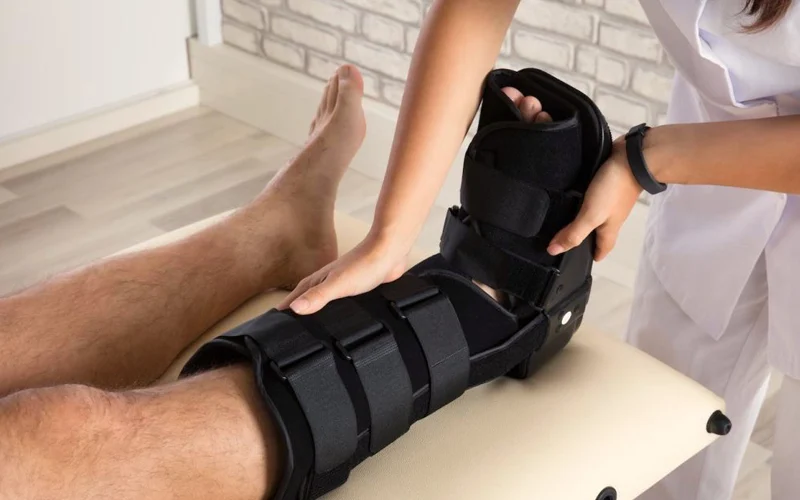Foot or ankle surgery can be a life-changing solution for chronic pain, instability, or injury. Whether you’re undergoing a procedure for bunions, fractures, tendon repair, arthritis, or deformity correction, preparation is crucial to a successful outcome. The days and weeks leading up to surgery can significantly impact your recovery experience and final results. Being informed, both physically and mentally prepared, and setting up your environment for post-operative healing are key parts of this process.
At Garden State Foot & Ankle Group, led by board-certified surgeon Dr. Manooj Prasad, we understand that any surgical procedure can feel overwhelming. That’s why we take the time to guide our patients through each phase, from pre-surgery planning to complete recovery. In this article, we’ll outline everything you need to know about how to prepare for foot or ankle surgery, so you can walk into your procedure with confidence and peace of mind.
Understanding Your Procedure and What to Expect
The first and most important step in preparing for foot or ankle surgery is fully understanding what the procedure entails. During your consultation with your surgeon, you should gain a comprehensive overview of your condition, the surgical method being used, and what outcomes are expected. This includes a discussion of the purpose of the surgery, whether it’s corrective, restorative, or a combination of both.
Ask your provider to explain the technique in layman’s terms, and don’t hesitate to request illustrations or diagrams. Knowing how the surgery will help resolve your condition — whether by straightening a misaligned toe, repairing a torn tendon, or removing arthritic bone — makes the entire process less intimidating. Your doctor should also review the potential risks and benefits so that you can give informed consent and feel empowered by your decision.
You’ll also want to be clear on what the post-surgery experience will look like. Will you be on crutches? Will you need to avoid putting any weight on the foot? How long before you can walk, drive, or return to work? Being mentally prepared for limitations can prevent frustration and allow you to make the necessary lifestyle adjustments in advance.
Making Health and Lifestyle Adjustments Before Surgery
In the weeks leading up to foot or ankle surgery, your body should be in the best condition possible to ensure optimal healing. Your doctor may advise changes such as quitting smoking, managing chronic health conditions, adjusting medications, or maintaining a healthy diet. These recommendations are not arbitrary — they directly impact how your body responds to surgery.
- Quit Smoking: Tobacco use decreases circulation and oxygen delivery, which are both vital for proper post-op healing. Even a short-term break from smoking can improve outcomes. Smokers have a higher risk of infection and delayed bone healing.
- Eat Nutritiously: A balanced diet high in lean protein, vegetables, and healthy fats helps your body prepare for surgical recovery. Stay hydrated to aid tissue regeneration. Consider supplementing with vitamins C and D after consulting your doctor.
- Manage Chronic Conditions: Control of diabetes, blood pressure, and other conditions is essential. Complications during and after surgery are more common when these are uncontrolled. A well-regulated body enhances anesthesia safety and supports smoother healing.
Maintaining these lifestyle practices can help ensure you’re physically prepared for surgery and reduce the chances of complications.
Preparing Your Home for Recovery
After foot or ankle surgery, your mobility will likely be limited for a period of time. That’s why preparing your home in advance can make a tremendous difference in your comfort and healing experience.
- Designate a Recovery Area: Set up a main-floor space with a recliner or bed, within easy reach of a bathroom. This avoids the need to climb stairs. Make sure you have enough space for mobility aids such as crutches or a walker.
- Eliminate Hazards: Remove area rugs, cords, or any items on the floor that might cause a fall. Keep walking paths clear and well-lit. Add night lights and handrails if possible to enhance safety.
- Gather Essentials: Have ice packs, pillows for elevation, medications, snacks, water, and entertainment close by. Stock up on any post-op supplies ahead of time. You might also consider using a bedside commode or a shower chair temporarily.
The more comfortable and accessible your space is, the easier your recovery will be.
Following Pre-Surgical Guidelines from Your Care Team
To ensure your foot or ankle surgery proceeds smoothly, it’s important to follow your care team’s pre-operative instructions closely. These guidelines are there to protect your safety and reduce the risk of complications.
- Fasting: Avoid food or drink as instructed, usually starting at midnight the night before surgery. This helps prevent complications from anesthesia. Be sure to confirm when you should stop eating or drinking.
- Medication Review: You may be asked to pause certain medications that could interfere with anesthesia or bleeding. Bring a complete list of prescriptions and supplements to your pre-op visit. Your doctor will guide you on what is safe to take.
- Pre-Op Hygiene: Use antimicrobial soap for your final shower and arrive clean and free of lotions or nail polish. Clean skin reduces the risk of post-surgical infection. Wear loose, comfortable clothes for your trip to the surgical center.
Following these steps ensures your surgical team can perform the operation in the safest environment possible.
Managing Stress and Preparing Mentally
Feeling nervous before foot or ankle surgery is perfectly normal. It’s important to manage your stress and prepare emotionally for the journey ahead.
Educate yourself about the procedure so there are fewer unknowns. Ask your surgeon questions and write down any concerns. Confidence often comes from knowledge. You can also use relaxation techniques such as breathing exercises, meditation, or gentle yoga in the days before surgery.
Support from loved ones can make a big difference. Let them know how they can assist — emotionally or practically — during your recovery period. A positive, forward-looking mindset will help you stay calm and focused. Keep reminding yourself of the goal — to walk again comfortably and pain-free.
What Happens Right After Surgery?
Immediately after your foot or ankle surgery, you’ll wake up in a recovery room where nurses will monitor your vital signs and comfort level. Your foot will be bandaged and possibly placed in a cast or surgical boot. The area may feel numb initially from anesthesia.
You’ll receive written and verbal instructions on caring for the surgical site. Elevation will be crucial to minimize swelling, and medication will help manage pain. Depending on the procedure, crutches, a walker, or a knee scooter may be necessary to stay non-weight-bearing.
Expect to attend several follow-up visits, which are vital for checking your incision, removing sutures if needed, and ensuring that healing is progressing as expected. Physical therapy might be recommended based on your recovery timeline. Don’t hesitate to report unusual symptoms like fever, excessive swelling, or increased pain.
Your Partners in Foot and Ankle Surgery Recovery
Preparing for foot or ankle surgery involves more than showing up on the day of the procedure. With the right information, planning, and mindset, you can take proactive steps toward a successful outcome. At Garden State Foot & Ankle Group, we take pride in delivering exceptional pre- and post-surgical care that’s tailored to your unique condition and goals.
Dr. Manooj Prasad brings decades of experience in advanced surgical techniques, helping patients overcome injuries, deformities, and chronic conditions through targeted treatment plans. From your initial consultation to your final follow-up, we’re with you every step of the way.
If you’re scheduled for foot or ankle surgery, or seeking expert guidance on whether surgery is the right choice, don’t wait. Reach out to our compassionate team today and let us help you step into a healthier future.
Contact Garden State Foot & Ankle Group
Toms River Office
📍 664 Commons Way Building 1
Toms River, NJ 08755
📞 Phone: (732) 557-9900
📧 Email: gsfagroup@gmail.com
Belleville Office
📍 1 Clara Maas Drive
Belleville, NJ 07109
📞 Phone: (973) 450-3035
🌐 Website: gsfagroup.com



0 Comments